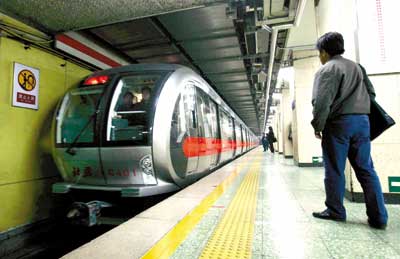Deficit difficulties
Subways are the most expensive urban transportation systems to build, costing around 500 million yuan ($77.3 million) per kilometer. A subway line about 30 kilometers long, for example, would cost up to 15 billion yuan ($2.32 billion) to build!equivalent to the total revenue generated by a medium-sized city in China in one year.
Zhou Yiming, vice director of the Urban Rail Transit Committee, said that "Demand for efficient and green public transportation is increasing in metropolises like Shanghai and Beijing, as well as in fast growing second-tier cities. In the next 10 years, China will see a big jump in metro line construction."
Among cities, Beijing is expected to boast the maximum number of subways, with the length of its subways forecast to increase from 75 kilometers in 2002 to 580 kilometers by 2015. The total length of subway lines in Beijing surpassed 300 km by the end of 2010.
The high cost of maintaining the subway requires huge governmental investment and high ticket fares that the public can hardly afford. Those factors could doom subway operation.
In Shenzhen, the deficit has reached about 1 billion yuan ($154.6 million) for the subway operation. It is predicted that the loss, including depreciation and debt interest, will reach 22 billion yuan ($3.4 billion) from 2012 to 2016.
In addition to high construction costs, the Beijing government also needs to provide subsidies of approximately 2 billion yuan ($309.2 million) each year to cover the deficits resulting from its subway operations.
In some cities, the local governments have to pay as much or more than 1,000 million yuan in subsidies every year to keep the subway running.
Hong Kong's subway industry may offer some insight, as its operation mode is a profit model. According to the MTR Corporation, it earns money by doing real estate business with the metro advantage. For example, it sets up property projects on the roof of 29 subway stations, which at least can break even with the operational deficit.
China's first metro line was in Beijing in 1969. Subway construction in China is booming and shows no signs of slowing down.


















